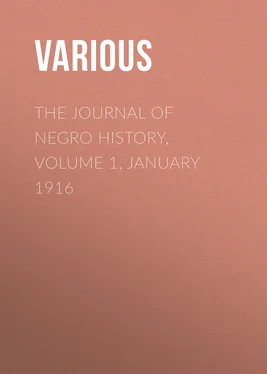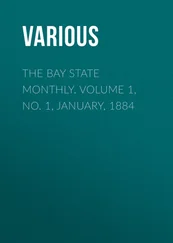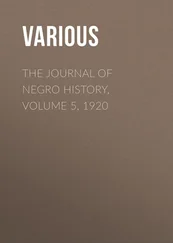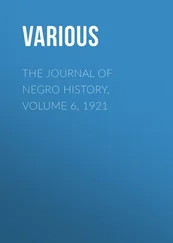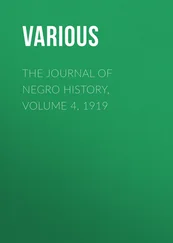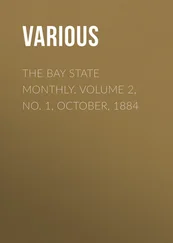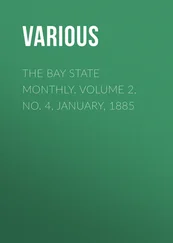Various - The Journal of Negro History, Volume 1, January 1916
Здесь есть возможность читать онлайн «Various - The Journal of Negro History, Volume 1, January 1916» — ознакомительный отрывок электронной книги совершенно бесплатно, а после прочтения отрывка купить полную версию. В некоторых случаях можно слушать аудио, скачать через торрент в формате fb2 и присутствует краткое содержание. Жанр: foreign_antique, periodic, История, foreign_edu, на английском языке. Описание произведения, (предисловие) а так же отзывы посетителей доступны на портале библиотеки ЛибКат.
- Название:The Journal of Negro History, Volume 1, January 1916
- Автор:
- Жанр:
- Год:неизвестен
- ISBN:нет данных
- Рейтинг книги:5 / 5. Голосов: 1
-
Избранное:Добавить в избранное
- Отзывы:
-
Ваша оценка:
- 100
- 1
- 2
- 3
- 4
- 5
The Journal of Negro History, Volume 1, January 1916: краткое содержание, описание и аннотация
Предлагаем к чтению аннотацию, описание, краткое содержание или предисловие (зависит от того, что написал сам автор книги «The Journal of Negro History, Volume 1, January 1916»). Если вы не нашли необходимую информацию о книге — напишите в комментариях, мы постараемся отыскать её.
The Journal of Negro History, Volume 1, January 1916 — читать онлайн ознакомительный отрывок
Ниже представлен текст книги, разбитый по страницам. Система сохранения места последней прочитанной страницы, позволяет с удобством читать онлайн бесплатно книгу «The Journal of Negro History, Volume 1, January 1916», без необходимости каждый раз заново искать на чём Вы остановились. Поставьте закладку, и сможете в любой момент перейти на страницу, на которой закончили чтение.
Интервал:
Закладка:
The spirit of the proslavery sympathizers was well exhibited in the upheaval which soon followed. This was the riot of July 30, 1836. It was an effort to destroy the abolition organ, The Philanthropist , edited by James G. Birney, a Southerner who had brought his slaves from Huntsville, Alabama, to Kentucky and freed them. The mob formed in the morning, went to the office of The Philanthropist , destroyed what printed matter they could find, threw the type into the street, and broke up the press. They then proceeded to the home of the printer, Mr. Pugh, but finding no questionable matter there, they left it undisturbed. The homes of James G. Birney, Mr. Donaldson and Dr. Colby were also threatened. The next homes to be attacked were those of Church Alley, the Negro quarter, but when two guns were fired upon the assailants they withdrew. It was reported that one man was shot but this has never been proved. The mob hesitated some time before attacking these houses again, several of the rioters declaring that they did not care to endanger their lives. A second onset was made, but it was discovered that the Negroes had deserted the quarter. On finding the houses empty the assailants destroyed their contents. 28 28 For a full account see Howe, "Historical Collections of Ohio," 225-226.
Yet undaunted by this persistent opposition the Negroes of Cincinnati achieved so much during the years between 1835 and 1840 that they deserved to be ranked among the most progressive people of the world. 29 29 Barber, "Report on the Condition of the Colored People in Ohio," 1840, and The Philanthropist , July 14 and 21, 1840.
Their friends endeavored to enable them through schools, churches and industries to embrace every opportunity to rise. These 2,255 Negroes accumulated, largely during this period, $209,000 worth of property, exclusive of personal effects and three churches valued at $19,000. Some of this wealth consisted of land purchased in Ohio and Indiana. Furthermore, in 1839 certain colored men of the city organized "The Iron Chest Company," a real estate firm, which built three brick buildings and rented them to white men. One man, who a few years prior to 1840 had thought it useless to accumulate wealth from which he might be driven away, had changed his mind and purchased $6,000 worth of real estate. Another Negro, who had paid $5,000 for himself and family, had bought a home worth $800 or $1,000. A freedman, who was a slave until he was twenty-four years old, then had two lots worth $10,000, paid a tax of $40 and had 320 acres of land in Mercer County. Another, who was worth only $3,000 in 1836, had seven houses in Cincinnati, 400 acres of land in Indiana, and another tract in the same county. He was worth $12,000 or $15,000. A woman who was a slave until she was thirty was then worth $2,000. She had also come into potential possession of two houses on which a white lawyer had given her a mortgage to secure the payment of $2,000 borrowed from this thrifty woman. Another Negro, who was on the auction block in 1832, had spent $2,600 purchasing himself and family and had bought two brick houses worth $6,000 and 560 acres of land in Mercer County, said to be worth $2,500. 30 30 These facts are taken from A. D. Barber's "Report on the Condition of the Colored People in Ohio" and from other articles contributed to The Philanthropist in July, 1840.
This unusual progress had been promoted by two forces, the development of the steamboat as a factor in transportation and the rise of the Negro mechanic. Negroes employed on vessels as servants to the travelling public amassed large sums received in the form of "tips." Furthermore, the fortunate few, constituting the stewards of these vessels, could by placing contracts for supplies and using business methods realize handsome incomes. Many Negroes thus enriched purchased real estate and went into business in Cincinnati. 31 31 In this case I have taken the statements of Negroes who were employed in this capacity.
The other force, the rise of the Negro mechanic, was made possible by overcoming much of the prejudice which had at first been encountered. A great change in this respect had taken place in Cincinnati by 1840. Many who had been forced to work as menial laborers then had the opportunity to show their usefulness to their families and to the community. Colored mechanics were then getting as much skilled labor as they could do. It was not uncommon for white artisans to solicit employment of colored men because they had the reputation of being better paymasters than master workmen of the more favored race. 32 32 The Philanthropist , July 14 and 24, 1840; and May 26, 1841.
White mechanics not only worked with colored men but often associated with them, patronized the same barber shop, and went to the same places of amusement. 33 33 Hickok, "The Negro in Ohio," 89.
In this prosperous condition the Negroes could help themselves. Prior to this period they had been unable to make any sacrifices for charity and education. Only $150 of the $1,000 raised for Negro education in 1835 was contributed by persons of color. In 1839, however, the colored people raised $889.30 for this purpose, and thanks to their economic progress, this task was not so difficult as that of raising the $150 in 1835. They were then spending considerable amounts for evening and writing schools, attended by seventy-five persons, chiefly adults. In 1840 Reverend Mr. Denham and Mr. Goodwin had in their schools sixty-five pupils each paying $3 per quarter, and Miss Merrill a school of forty-seven pupils paying the same tuition. In all, the colored people were paying these teachers about $1,300 a year. The only help the Negroes were then receiving was that from the Ladies' Anti-Slavery Society, which employed one Miss Seymour at a salary of $300 a year to instruct fifty-four pupils. Moreover, the colored people were giving liberally to objects of charity. Some Negroes burned out in 1839 were promptly relieved by members of their own race. A white family in distress was befriended by a colored woman. The Negroes contributed also to the support of missionaries in Jamaica and during the years from 1836 to 1840 assisted twenty-five emancipated slaves on their way from Cincinnati to Mercer County, Ohio. 34 34 The Philanthropist , July 14 and 21, 1840.
During this period they had made progress in other than material things. Their improvement in religion and morals was remarkable. They then had four flourishing Sabbath Schools with 310 regular attendants, one Baptist and two Methodist churches with a membership of 800, a "Total Abstinence Temperance Society" for adults numbering 450, and a "Sabbath School or Youth's Society" of 180 members. A few of these violated their pledges, but when we consider the fact that one fourth of the entire colored population belonged to temperance organizations while less than one tenth of the whites were thus connected, we must admit that this was no mean achievement. Among the Negroes public sentiment was then such that no colored man could openly sell intoxicating drinks. This growing temperance was exhibited, too, in the decreasing fondness for dress and finery. There was less tendency to strive merely to get a fine suit of clothes and exhibit one's self on the streets. Places of vice were not so much frequented and barber shops which on Sundays formerly became a rendezvous for the idle and the garrulous were with few exceptions closed by 1840. This influence of the religious organizations reached also beyond the limits of Cincinnati. A theological student from the State of New York said after spending some time in New Orleans, that the influence of the elevation of the colored people of Cincinnati was felt all the way down the river. Travelers often spoke of the difference in the appearance of barbers and waiters on the boats. 35 35 The Philanthropist , July 21, 1840.
Интервал:
Закладка:
Похожие книги на «The Journal of Negro History, Volume 1, January 1916»
Представляем Вашему вниманию похожие книги на «The Journal of Negro History, Volume 1, January 1916» списком для выбора. Мы отобрали схожую по названию и смыслу литературу в надежде предоставить читателям больше вариантов отыскать новые, интересные, ещё непрочитанные произведения.
Обсуждение, отзывы о книге «The Journal of Negro History, Volume 1, January 1916» и просто собственные мнения читателей. Оставьте ваши комментарии, напишите, что Вы думаете о произведении, его смысле или главных героях. Укажите что конкретно понравилось, а что нет, и почему Вы так считаете.
